To kill a tree safely, timing and technique matter. During the active growth season, use methods like girdling or frilling to disrupt nutrient flow. If cutting down the tree, always wear personal protective equipment and guarantee you have an escape route. Cut branches first for visibility, then angle trunk cuts away from structures. Don't forget to apply herbicide to the stump immediately to prevent regrowth. After removal, fill the hole with topsoil and monitor for new growth. Following these steps can help you achieve your goal while minimizing risks—stick around for more detailed techniques and tips.
Key Takeaways
- Choose the optimal time for herbicide application during the active growing season, from early spring to late fall, for best results.
- Utilize the hack and squirt method by making cuts in the trunk and applying herbicide for targeted absorption and effective tree death.
- Girdling is an alternative technique; remove bark strips around the trunk to disrupt nutrient flow and enhance herbicide effectiveness.
- Always wear personal protective equipment (PPE) like safety glasses and gloves to ensure safety during the tree removal process.
- Monitor the area post-treatment for any new growth and apply herbicide immediately to prevent regrowth from leftover roots or seeds.
Reasons for Tree Removal
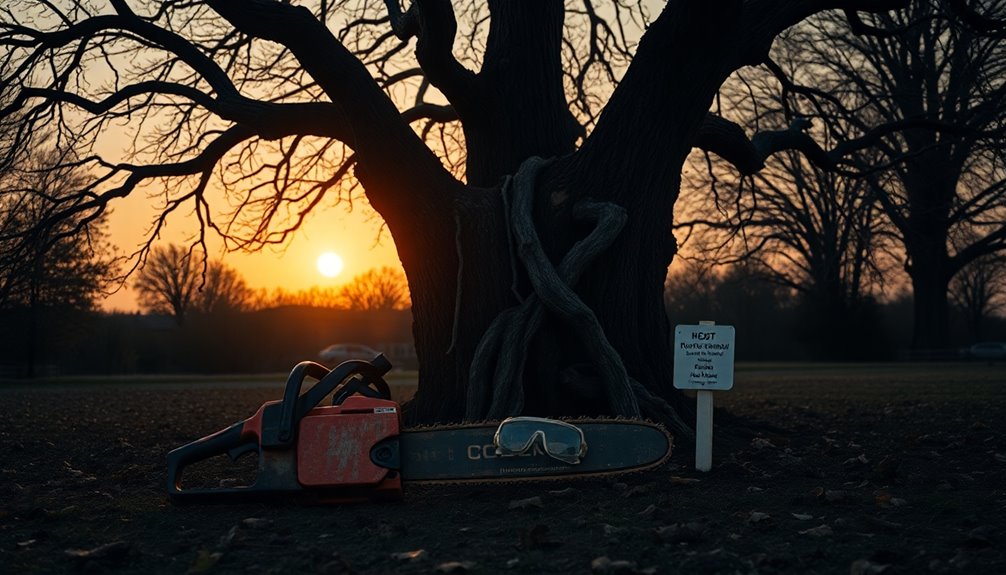
When you notice a tree planted too close to your home, it's crucial to take into account its removal. Trees can compromise your home's structural integrity as their roots invade foundations, causing costly damage.
If you have leaning trees, they pose significant risks during storms, making a tree removal service a wise choice.
Invasive tree species disrupt local ecosystems, leading to biodiversity loss as they outcompete native plants. Overcrowded tree areas restrict healthy growth, limiting sunlight and nutrients vital for surrounding flora.
Additionally, certain tree species can trigger allergies, making your living environment uncomfortable. Evaluating these factors can help you determine whether it's time to remove problematic trees for your safety and the health of your landscape.
Safety Precautions to Consider
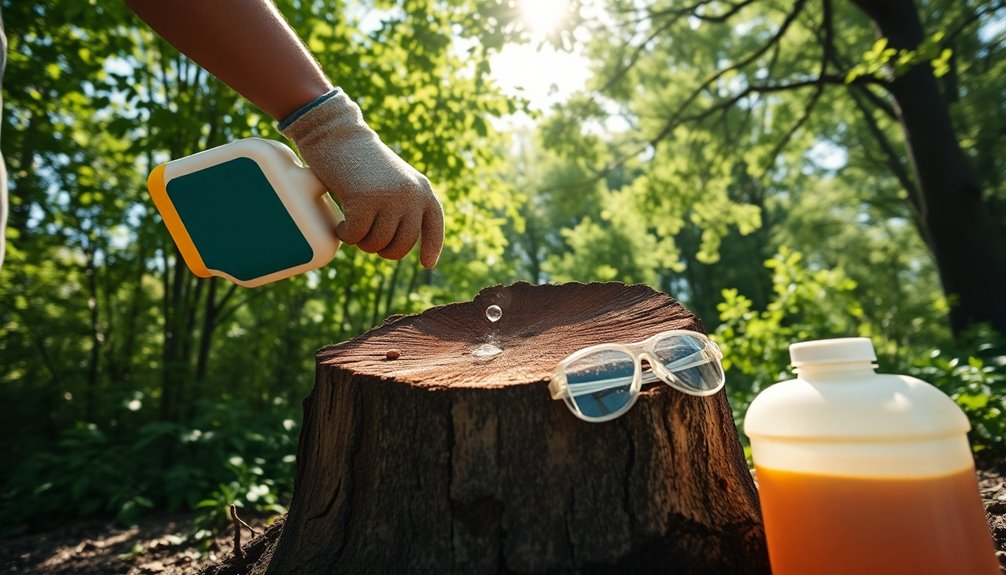
Before you start any tree removal, make certain you gear up with personal protective equipment like safety glasses, gloves, and hard hats.
It's also smart to have a first aid kit ready and know your emergency procedures, just in case.
Personal Protective Equipment
Safety should be your top priority when tackling tree removal tasks. Always wear personal protective equipment (PPE) to shield yourself from potential hazards. Here's a quick overview of essential gear:
| Gear | Purpose |
|---|---|
| Safety Glasses | Protects eyes from flying debris |
| Gloves | Prevents hand injuries |
| Safety-Toe Boots | Safeguards against falling objects |
| Hard Hats | Shields head from impacts |
| Chemical-Resistant Gloves | Minimizes skin exposure to chemicals |
When applying herbicides, wear long sleeves and chemical-resistant gloves to avoid allergic reactions. Keep a first aid kit on hand and understand emergency procedures to guarantee you're prepared for any accidents during your tree removal projects.
Emergency Preparedness Measures
Preparing for emergencies during tree removal is essential, as unexpected situations can arise at any moment.
Always wear personal protective equipment like safety glasses, gloves, and hard hats to minimize injury risks. Keep a first aid kit on-site to address any potential injuries quickly.
Before starting tree removal operations, conduct a thorough work area inspection to identify hazards such as unstable branches or uneven ground.
Create an emergency plan that includes contact information for local emergency services and a designated meeting point for all workers. This preparation helps guarantee everyone knows what to do in case of an accident, greatly improving safety and response time during emergencies.
Stay vigilant, and prioritize safety for a successful tree removal process.
Manual Removal Techniques
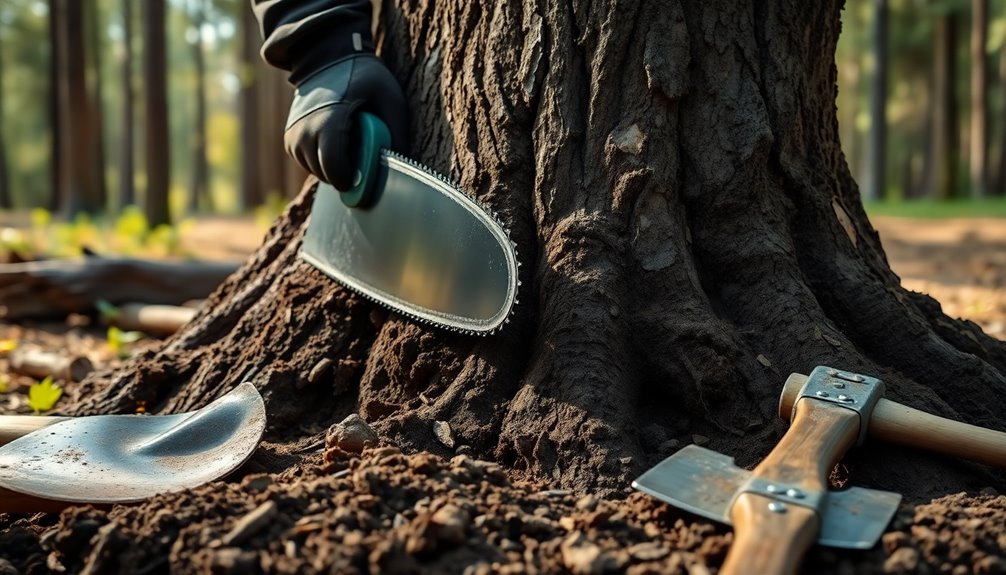
When you tackle unwanted seedlings, hand-pulling is your best bet if you catch them early.
For small trees, trimming the branches makes it easier to dig around the trunk and remove the roots effectively.
Using tools like a hori-hori knife can really speed up the process and help you get the job done right.
Seedling Hand-Pulling Methods
One effective method for controlling tree seedlings is hand-pulling, especially during their early growth stages.
To increase your success, water the area beforehand to loosen the soil, making it easier to extract the entire root system.
When you hand-pull, grasp the seedling close to the base to minimize the risk of breaking the stem, which can lead to regrowth from any remaining roots.
Regular monitoring of the area is essential afterward, as new seedlings may emerge, requiring additional hand-pulling.
For tougher soil conditions, consider using a hori-hori knife for precise cutting around the root zone.
This combination of techniques will help guarantee you effectively manage those pesky seedlings and prevent future issues.
Digging Techniques for Trees
Effective digging techniques are essential for removing unwanted trees, especially those under 5 inches in diameter.
Start by watering the area around the tree to loosen tough roots. When you're ready to dig, remember to begin 1.5 to 2 feet away from the trunk, allowing you to sever as much of the root system as possible.
Use these steps for efficient manual removal:
- Cutting through roots with a hori-hori knife enhances your ability to remove the tap root.
- Loosen tough roots carefully to avoid damaging the tree's structure.
- Pull the tree out once the roots are sufficiently cut and loose.
Tools for Efficient Removal
To tackle small tree removal efficiently, you'll want the right tools at your disposal. A pruning saw or hori-hori knife is essential to cut branches before you dig. For seedlings, hand-pulling works best, especially if you do it early.
Watering the area can help loosen tough tree roots, making extraction easier. When you're ready to remove a tree, start digging about 1.5 to 2 feet from the trunk to effectively sever roots and minimize damage to surrounding plants.
Use a shovel to carefully excavate the root ball, ensuring you remove the taproot for complete removal. Finally, regular monitoring of the area post-removal is vital for spotting any new growth and addressing it promptly to prevent reinfestation.
Girdling and Frilling Methods

Girdling and frilling methods are two effective techniques for killing a tree by disrupting its nutrient transport system. Here's how you can do it:
- Girdling: Remove a strip of bark around the trunk, making cuts 6 inches apart and ½ to 1½ inches deep. This method may take years for tree death to occur.
- Frilling: Make downward-facing cuts around the trunk, leaving sections of bark attached. It's labor-intensive but allows for natural decay.
- Herbicide Application: Immediately apply herbicide to the cuts to enhance absorption and expedite tree death.
Keep in mind that both methods can create standing dead trees, which may impact local wildlife habitats.
Cutting Down Trees
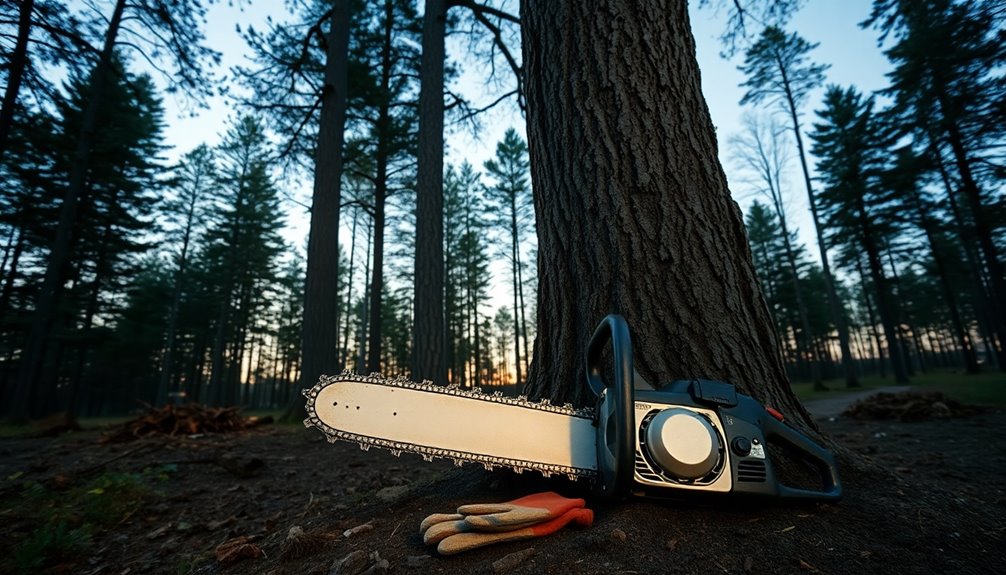
When you're cutting down trees, safety should be your top priority.
Make sure you use the right techniques, like starting with the branches and cutting close to the ground, to control the fall of the trunk.
Don't forget to gear up with proper protective equipment to keep yourself safe while you work.
Safety Precautions Required
Before you start cutting down a tree, it's vital to take safety precautions seriously. Wearing personal protective equipment (PPE) can save you from serious injuries.
Here are three important items you should never skip:
- Safety glasses: Protect your eyes from flying debris.
- Gloves: Grip your chainsaw securely while safeguarding your hands.
- Hard hats: Shield your head from falling branches.
Additionally, establish a clear escape route to guarantee a quick exit in case the tree falls unexpectedly.
Always assess the surrounding area for obstacles and familiarize yourself with local tree cutting regulations, including any necessary permits.
Proper Cutting Techniques
Having taken the necessary safety precautions, you're ready to focus on the proper cutting techniques for removing a tree. Start by using a chainsaw or pruning saw to remove lower branches, which reduces weight and improves visibility.
When you're ready to cut the trunk, make your cut as close to the ground as possible while angling it to direct the fall away from structures. To enhance safety, use a guide rope to control the direction of the tree's fall.
After the tree falls, apply herbicide to the freshly cut stump immediately to prevent regrowth.
Chemical Application Strategies
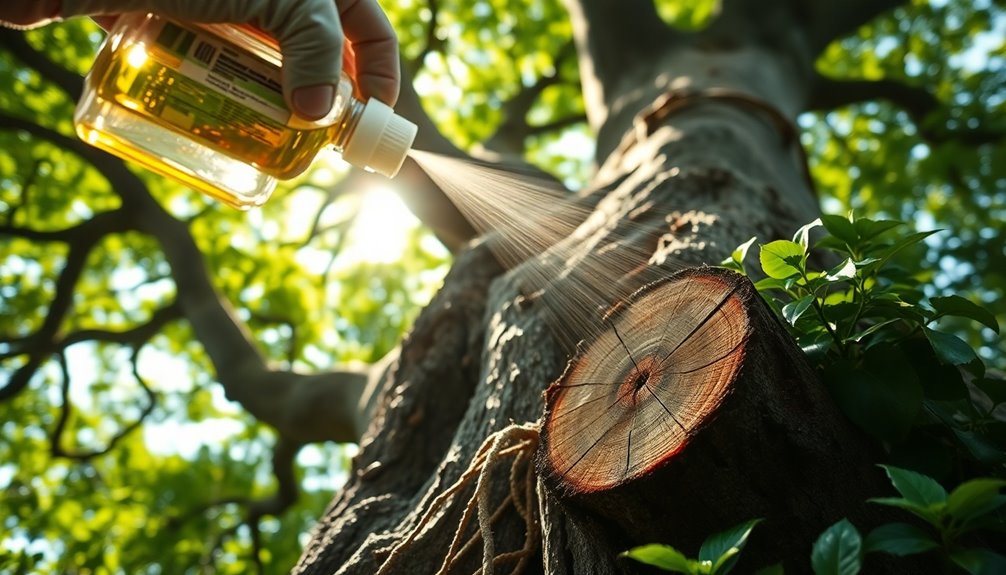
To effectively kill a tree using chemical application strategies, timing and technique are essential. Start your herbicide application during the tree's active growing season, from early spring to late fall, to maximize chemical absorption.
Here are three effective methods:
- Basal bark treatments: Apply an oil-soluble herbicide to the lower trunk, focusing on the lower 12 to 18 inches.
- Hack and squirt method: Make cuts into the tree trunk and apply the herbicide directly into those cuts for targeted absorption.
- Drilling holes: Drill holes into the stump and fill them with herbicide, covering with a tarp to enhance absorption and minimize environmental impact.
Always follow label instructions on herbicide products to avoid unintended harm to surrounding vegetation and ecosystems.
Post-Removal Actions

Once you've removed a tree, it's vital to take immediate steps to prevent regrowth and maintain the area's appearance.
Start with your post-removal actions by removing any remaining debris and roots. Next, fill the resulting hole with topsoil to promote proper drainage and avoid water accumulation that could attract pests.
To further prevent regrowth and enhance the landscape, consider applying mulch or seeding grass in the area. It’s important to monitor the area for new growth from any leftover roots or seeds, taking prompt action if sprouts appear. Additionally, regularly inspecting the site will help ensure that any new growth is addressed before it becomes a larger problem. Utilizing the best methods for killing grass, such as applying a natural herbicide or integrating solarization techniques, can effectively support your efforts in maintaining a healthy landscape. Remember, consistency is key to long-term success, so remain vigilant and proactive in your maintenance routine.
Finally, allow at least one year before you plant new trees in the same spot to confirm the soil is replenished and any old roots have decayed.
Stump Treatment Options

When you've got a tree stump left behind, tackling it promptly can prevent unwanted regrowth and maintain your landscape's aesthetics.
Here are three effective stump treatment options:
- Stump Grinding: This method guarantees complete removal, costing between $170 to $500 depending on size and accessibility.
- Herbicide Application: Apply herbicide to the outer 3 inches of the stump right after cutting to stop regeneration.
- Salt in Drilled Holes: Drill holes into the stump and fill them with salt for accelerated decomposition and to inhibit regrowth.
After treatment, cover the stump with a tarp to enhance effectiveness and regularly monitor the area to catch any new growth.
Just remember, salt can harm nearby vegetation, so use it with caution.
Common Myths Debunked
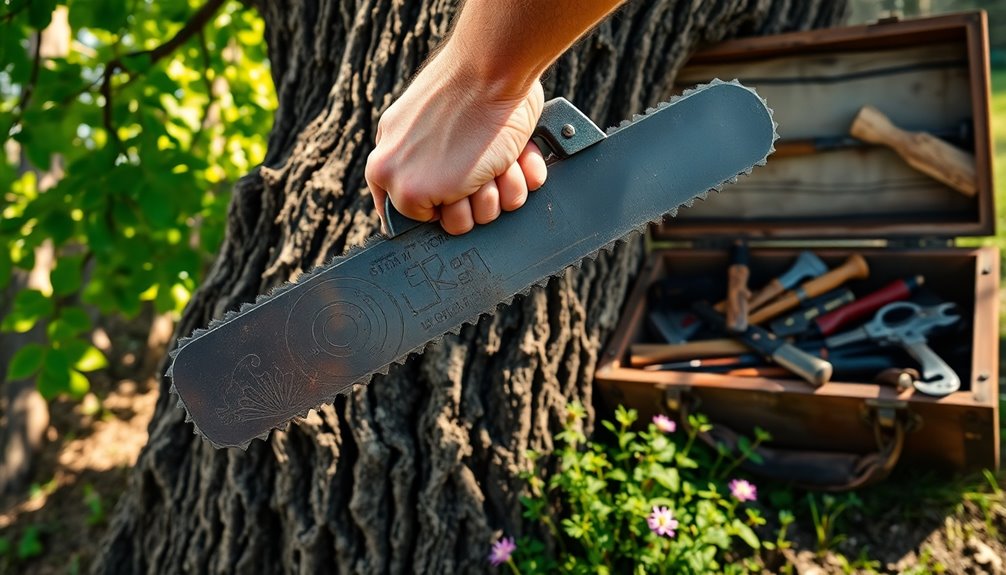
Proper stump treatment is essential for preventing unwanted regrowth, but many misconceptions surround the best methods for killing trees.
For instance, using bleach to kill a tree is ineffective and can harm soil health, making it a poor choice for tree management. The idea that copper nails can kill a mature tree is misleading; you'd need many nails and methods like girdling the tree for any chance of success.
Simply cutting down a tree won't prevent regrowth without proper herbicide application. Additionally, while some think excessive salt is a foolproof solution, it can damage surrounding vegetation.
Understanding these myths debunked is vital for effective tree care and maintaining a healthy landscape.
Reliable Resources for Guidance
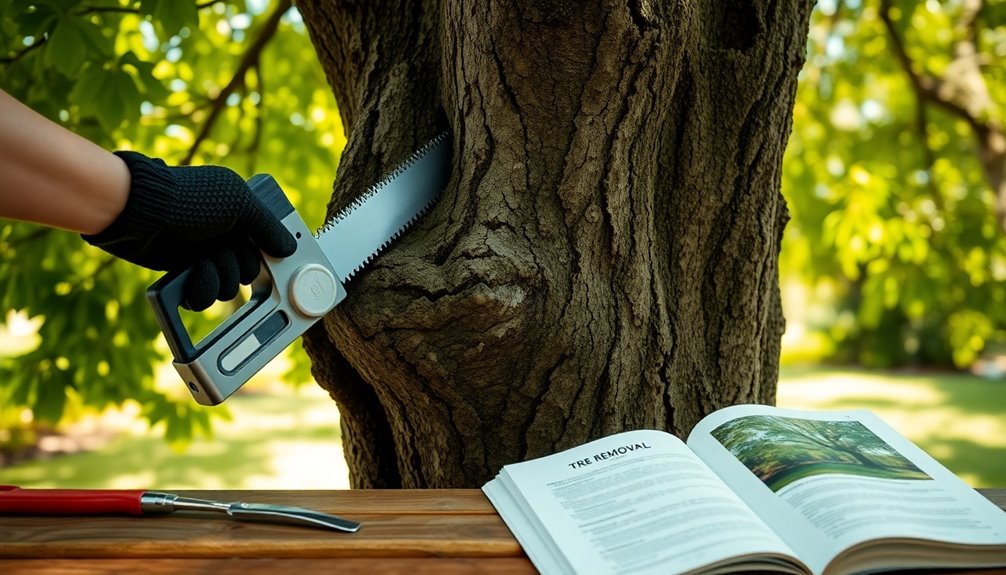
Finding trustworthy resources is essential for anyone looking to effectively kill a tree or manage unwanted vegetation. Here are some reliable guides you can use:
- The Spruce: Offers peer-reviewed studies on tree management practices, including stump grinding and herbicide use.
- Ohio State University: Provides detailed information on tree removal and controlling undesirable plants, ensuring you're informed.
- HomeAdvisor: Helps you budget for tree service, offering cost estimates for stump grinding and related services.
Don't forget to consult the EPA or your state's pesticide regulatory agencies for compliance with legalities surrounding herbicide use. Additionally, understanding herbicide application techniques is crucial for effective results.
With the right resources, you'll confidently tackle your tree management needs, whether you're a Master Gardener or a novice.
Frequently Asked Questions
What Is the Most Effective Step of Killing a Tree?
The most effective step in killing a tree is girdling.
You'll want to sever the bark completely around the trunk, disrupting the flow of nutrients and water. This method takes time, leading to the tree's death over the years.
If you need quicker results, consider cutting the tree and applying a concentrated herbicide to the stump immediately.
This allows the chemical to absorb rapidly into the roots, ensuring effective elimination.
What Is the Best Way to Kill Unwanted Trees?
To kill unwanted trees effectively, you've got a few options.
Chemical methods, like the hack and squirt technique, work well by applying herbicide to cuts in the trunk.
Girdling strips the bark and disrupts nutrient flow, though it takes longer.
If you're dealing with smaller trees, manual removal is straightforward—just cut and dig out the roots.
For young trees, try basal bark treatment with an oil-soluble herbicide from spring to fall.
Always follow safety guidelines!
What Is the Proper Method of Killing a Tree?
Killing a tree is like pulling a stubborn weed; it takes the right technique. The proper method depends on the tree's size.
For larger trees, you might want to use the hack-and-squirt method, where you cut into the bark and apply herbicide.
For smaller ones, digging out the roots works well, especially if you loosen the soil first.
Always follow herbicide instructions closely to avoid harming nearby plants and guarantee safety.
Can You Kill the Tree in 20 Minutes Till Dawn?
You can't realistically kill a tree in just 20 minutes.
While you might cut it down quickly, it takes time for methods like herbicide application to work.
Even if you use salt or vinegar, those are more effective on seedlings than mature trees.
If you need immediate results, consider hiring professionals who can use specialized techniques, but remember that complete effectiveness still won't happen within such a short timeframe.
Conclusion
So, you thought killing a tree was as simple as swinging an axe, huh? Ironically, it's a bit more complex than that. With the right techniques and precautions, you can safely remove your leafy adversary without turning your yard into a war zone. Remember, trees may be tough, but your approach doesn't have to be. Embrace the challenge, follow the guidelines, and soon you'll be the proud owner of a tree-free space—who knew gardening could feel so… liberating?









